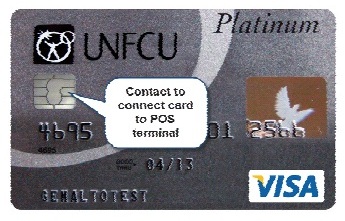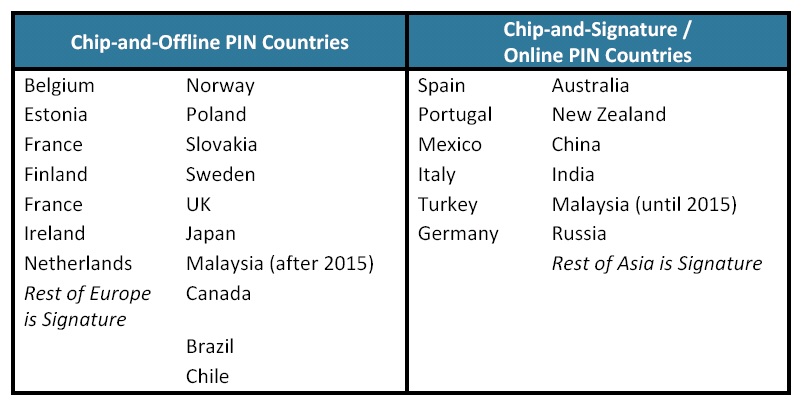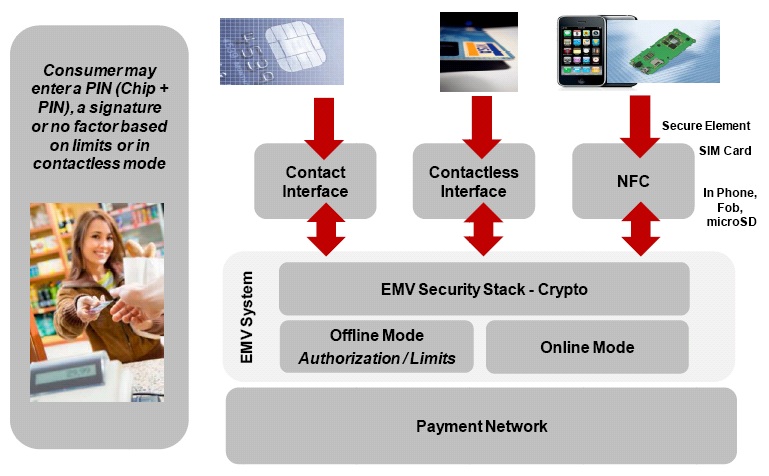
Two
major payments technologies are coming to the
As
these two approaches come forward at the same time, they have caused
considerable concern and confusion among merchants and issuers. Facing a
market-driven imperative around NFC (mobile commerce is hot!) and a
security-driven imperative around EMV (counterfeiting magstripe cards is
too easy!); merchants in particular are confronted by critical choices
regarding their payment acceptance systems. Merchants operate in the
real world of existing payment infrastructure and have committed massive
investments into that infrastructure.
The
twin technologies of EMV and NFC are especially important to large
merchants as they plan for new products and payment acceptance systems
in a world that is increasingly homogeneous, where customers travel
between regions and expect a consistent consumer experience. The payment
step in the transaction cycle is a critical element of that overall
experience. Of course, layered into the customer experience is concern
for payment security and PCI compliance.
EMV
alone is a significant upgrade to the
This
Payments Trends update answers key questions around EMV’s arrival in the
EMV is
a payment security approach based on smartcard technology that adds
dynamic data to the transaction stream that, unlike standard static
magstripe card data, renders replay of payment transactions impossible.
More important, because every card contains its own microprocessor chip
(that’s why it is called a smartcard), EMV cards are impossible to
counterfeit economically.
While
improvements to magstripe security exist, EMV is the technology that the
payment card brands have chosen to stop card counterfeiting. The
organization responsible for development of EMV standards is EMVCo, a
consortium owned by MasterCard, Visa, AMEX and JCB. EMV is now in wide
global deployment.
An EMV
card is exactly the same size and thickness as a standard magstripe card
(see Exhibit 1). An EMV card is not swiped like a magstripe card. It is
inserted into a slot on the P05 terminal. On the face of the card is a
metal contact. When inserted, the contact connects the card to the
terminal and the two devices can communicate. Of course, almost all EMV
cards also have a magstripe for use at terminals that haven’t been
upgraded to EMV.
Exhibit 1: Contact EMV Card

EMV also supports contactless payments. A card capable of both contact
and contactless transactions is called a dual interface card. A dual
interface card can be either tapped at the P05 terminal or inserted into
the EMV card reader. In
EMV
cards can be deployed for online and offline authorization. Online
authorization uses a process similar to our magstripe authorization
process today where the transaction is verified immediately via an
online connection to the card issuer. Offline authorization is
authorization between the card and the acceptance device, without online
authorization. Offline authorization is called chip and PIN. The PIN
unlocks the card. In many markets, a PIN is used for credit transactions
as well. The choice of whether to use offline authorization generaHy
runs on a national basis. Depending on the issuer and/or the merchant’s
preferences based on transaction type and size, the cardholder may or
may not need to enter a PIN.
Given
that virtually 100% of
EMV is
a global standard. The
Exhibit 2: Online and Offline PIN Countries

The
venerable magstripe has served the payment card well for decades,
enabling untold numbers of electronic transactions. But the magstripe is
no longer able to fend off fraudsters armed with low cost magstripe
readers, card duplication gear and Internet-sourced card data. As those
fraudsters have proven over and over, it is simply too easy to create
counterfeit payment cards.
The
result has been an outbreak of card skimming that has cost merchants,
card issuers, and consumers millions. With most of the developed world
now using EMV to prevent counterfeit card fraud, card fraud is migrating
more and more to the
EMV
will protect against three issues when compared to magstripe:
1.
Counterfeit cards. EMV cards are virtually impossible to copy.
2.
Skimming. Because each transaction is unique and cards cannot be
economically counterfeited, skimming an EMV card is not worthwhile.
3.
Offline interceptions – “man in the middle” attacks – are thwarted
because each transaction contains unique, encrypted data that is of no
use to the fraudster.
While
it has been anticipated for years, it appears that the
To
move the payments ecosystem — issuers, acquirers and merchants — Visa
announced three separate programs:
1.
Technology Innovation Program (TIP).
The TIP program allows merchants to skip their annual Visa PCI
compliance validation once 75 percent of their Visa transactions are
originated on chip-enabled (EMV compliant) POS terminals. The U.S. TIP
program goes into effect on October 1, 2012. Qualifying P05 terminals
must accept both contact and contactless chip cards and contactless
transactions from NFC equipped mobile devices. Visa’s TIP program does
not eliminate a merchant’s PCI requirements, just the validation once
three quarters of Visa transactions originate from EMV-capable
terminals.
2.
Merchant Acquirers Get Ready.
By April
1, 2013, acquirers must be ready to process the cryptographically
generated dynamic data associated with each EMV transaction.
3.
Merchant Get Ready — Liability
Shift. After
October 15, 2015, merchant acquirers will be responsible for any
counterfeit or fraud losses on a transaction if a cardholder with an EMV
card must use the magstripe on that EMV card because the merchant does
not have an EMV-capable POS terminal. The merchant acquirer is likely
to, in turn, make the merchant responsible for the fraud on that
transaction. This liability shift will be in effect for both domestic
and cross-border POS transactions. Gasoline retailers have another two
years to prepare, given the high cost of upgrading their automatic fuel
dispensers. The phrase “liability shift” is frequently used in
discussions over EMV rollout. The purpose of the liability shift is to
encourage the transition to chip cards. With chip-to-chip transactions,
there is no concern regarding liability shift.
Visa’s
pushing for a comparatively swift EMV rollout in the
What
is MasterCard Doing? To date, the second largest card network is
encouraging the EMV transition only on its ATM business. It is targeting
inter-regional Maestro ATM transactions. But it hasn’t announced any
endorsement for a U.S. EMV rollout.
EMV
issuance in the
For
many
Exhibit 3: EMV - Multiple Form Factors, Multiple Communications Links

Of
course, expecting all security troubles to be resolved by one technology
is wishful thinking. EMV deployment has suffered from this
“silver-bullet-itis” as well but it is no more a cure-all than card
number encryption. Payments security is about layers of defense because
multiple layers work better. For example, the best ecommerce merchants,
the Merchant Risk Council’s Platinum members, use on average 7.9 tools
to manage their fraud risk. Weaker performers use fewer tools. For point
of sale payments, EMV creates a secure environment by eliminating the
counterfeit and transaction replay risks, a pair of big holes.
ü
To
prepare for EMV and mobile payments, merchants of almost any size
are wise to follow the following recommendations:
If you’re refreshing your terminal estate, buy EMV capable terminals.
Spend the extra $10. Make sure you’re ready to take “chip and PIN”
payments.
ü
If mobile
commerce and payments are on your mind, and they should be. Purchase
terminals that support contact and contactless EMV. Look for
terminals where the contactless capability is built into the terminal
directly, not via an add-on card or external device. That will keep the
cost lower. Buy contactless payment capability if you plan to get more
than two years (and you do) out of your POS terminals. This positions
you for both today’s contactless card payments and for the coming era of
NFC-based transactions.
ü
If you
haven’t already, consider PIN debit acceptance. Because EMV does support
PIN, nearly 100% of EMV terminals include PIN pads. So put those pads,
and the lower cost of debit acceptance, to work.
ü
Drive a
hard bargain. There is going to be heavy competition for the POS upgrade
business.
EMV
does a lot to improve the counterfeit card problem at the point of sale.
By reducing the availability of static data, it will decrease, in the
long run, card-not-present fraud during e-commerce and mobile commerce
transactions. The ability to skim cards goes away. In the short to
medium term, as card present fraud becomes more difficult, card not
present fraud will increase as fraud migrates to the less secure
channel.
As
NFC-equipped smartphones roll out in 2012 and beyond, the EMV shift can
be used to increase payment security for mobile payments using NFC. EMV
provides an important part of the security infrastructure needed for a
wide range of mobile transactions. POS payments and e-commerce payments
can also leverage, with the appropriate hardware, EMV and, in the case
of mobile handsets, the hardware is there.
With
both of these payment technologies arriving at the same time, the smart
merchant will plan to support both and take advantage of the security
and marketing advantages each offers.